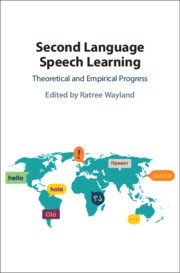Book contents
- Second Language Speech Learning
- Second Language Speech Learning
- Copyright page
- Dedication
- Contents
- Figures
- Tables
- Contributors
- Preface
- Acknowledgments
- Part I Theoretical Progress
- Chapter 1 The Revised Speech Learning Model (SLM-r)
- Chapter 2 The Revised Speech Learning Model (SLM-r) Applied
- Chapter 3 New Methods for Second Language (L2) Speech Research
- Chapter 4 Phonetic and Phonological Influences on the Discrimination of Non-native Phones
- Chapter 5 The Past, Present, and Future of Lexical Stress in Second Language Speech Production and Perception
- Part II Segmental Acquisition
- Part III Acquiring Suprasegmental Features
- Part IV Accentedness and Acoustic Features
- Part V Cognitive and Psychological Variables
- Index
- References
Chapter 1 - The Revised Speech Learning Model (SLM-r)
from Part I - Theoretical Progress
Published online by Cambridge University Press: 21 January 2021
- Second Language Speech Learning
- Second Language Speech Learning
- Copyright page
- Dedication
- Contents
- Figures
- Tables
- Contributors
- Preface
- Acknowledgments
- Part I Theoretical Progress
- Chapter 1 The Revised Speech Learning Model (SLM-r)
- Chapter 2 The Revised Speech Learning Model (SLM-r) Applied
- Chapter 3 New Methods for Second Language (L2) Speech Research
- Chapter 4 Phonetic and Phonological Influences on the Discrimination of Non-native Phones
- Chapter 5 The Past, Present, and Future of Lexical Stress in Second Language Speech Production and Perception
- Part II Segmental Acquisition
- Part III Acquiring Suprasegmental Features
- Part IV Accentedness and Acoustic Features
- Part V Cognitive and Psychological Variables
- Index
- References
Summary
Here we present the revised Speech learning model (SLM-r), an individual differences model which aims to account for how phonetic systems reorganize over the life span in response to the phonetic input received during naturalistic second language (L2) learning. We first review research leading to the formulation of Speech Learning Model, or SLM (Flege, 1995), before presenting a synthesis of that model and then its revision. The SLM-r proposes that the mechanisms and processes needed for native language (L1) acquisition remain accessible for use in L2 learning, without change or exception, across the life span. By hypothesis, the formation or non-formation of new phonetic categories for L2 sounds will depend on the precision of L1 categories at the time L2 learning begins, the perceived phonetic dissimilarity of an L2 sound from the closest L1 sound, and the quantity and quality of L2 input that has been received. According to the SLM-r, the phonetic categories making up the L1 and L2 phonetic subsystems interact with one another dynamically and are updated whenever the statistical properties of the input distributions defining L1, L2, and composite L1-L2 categories (diaphones) change.
- Type
- Chapter
- Information
- Second Language Speech LearningTheoretical and Empirical Progress, pp. 3 - 83Publisher: Cambridge University PressPrint publication year: 2021
References
- 143
- Cited by



